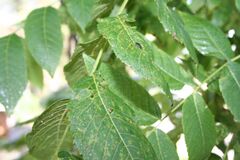Biology:Geosmithia
| Geosmithia | |
|---|---|

| |
| Geosmithia morbida on leaves of black walnut | |
| Scientific classification | |
| Kingdom: | |
| Division: | |
| Class: | |
| Order: | |
| Family: | |
| Genus: | Geosmithia Pitt (1979)
|
| Type species | |
| Geosmithia lavendula (Raper & Fennell) Pitt (1979)
| |
Geosmithia is a genus of anamorphic fungi of uncertain familial placement in the order Hypocreales. The genus, circumscribed by Australian mycologist John Pitt in 1979,[1] is widely distributed. A 2008 estimate placed ten species in the genus,[2] but several new species have since been described. Thousand cankers disease, which affects economically important black walnut (Juglans nigra) populations in North America, is caused by Geosmithia morbida.[3]
Species in the genus are generally similar to those in Penicillium, but can be distinguished from them by forming cylindrical conidia from rough-walled phialides. Additionally, the conidia of Geosmithia do not have a green color, in contrast to the characteristic blue-grey or green-grey conidia of Penicillium. Some Geosmithia species have teleomorphic forms that are classified in the genus Talaromyces. However, Geosmithia is a polyphyletic taxon with evolutionary affinities to at least three groups of the euascomycete lineage within the Ascomycota.[4] The generic name Geosmithia honors British mycologist George Smith.[1]
Species
As accepted by Species Fungorum;[5]
- Geosmithia brunnea Y.T. Huang, M. Kolařík & Hulcr (2017)
- Geosmithia carolliae A.O.B. Cunha, A.R. Machado & Souza-Motta (2018)
- Geosmithia cnesini M. Kolařík & Kirkendall (2015)
- Geosmithia eburnea Yaguchi, Someya & Udagawa (1994)[6]
- Geosmithia emersonii (Stolk) Pitt (1979)
- Geosmithia eupagioceri M. Kolařík (2010)[7]
- Geosmithia fassatiae M. Kolařík, Kubátová & Pažoutová (2005)[8]
- Geosmithia flava M. Kolařík, Kubátová & Pažoutová (2004)
- Geosmithia langdonii M. Kolařík, Kubátová & Pažoutová (2005)[8]
- Geosmithia lavendula (Raper & Fennell) Pitt (1979)
- Geosmithia malachitea Yaguchi & Udagawa (1993)[9]
- Geosmithia microcorthyli M. Kolařík (2010)
- Geosmithia morbida M. Kolařík, Freeland, C. Utley & Tisserat (2010)
- Geosmithia namyslowskii (K.W. Zaleski) Pitt (1979)
- Geosmithia obscura M. Kolařík, Kubátová & Pažoutová (2005)[8]
- Geosmithia omnicola Pepori M. Kolařík, Bettini, Vettraino & Santini (2015)
- Geosmithia proliferans Y.T. Huang, M. Kolařík, Kasson & Hulcr (2017)
- Geosmithia putterillii (Thom) Pitt (1979)
- Geosmithia rufescens M. Kolařík (2010)[7]
- Geosmithia swiftii Pitt (1979)
- Geosmithia tibetensis Y.M. Wu & T.Y. Zhang (2013)[10]
- Geosmithia ulmacea Pepori, M. Kolařík, Bettini, Vettraino & Santini (2015)
- Geosmithia xerotolerans Rodr.-Andr., Cano & Stchigel (2018)
Former species;[5]
- G. argillacea (Stolk, H.C. Evans & T. Nilsson) Pitt (1979) = Rasamsonia argillacea Aspergillaceae family
- G. cylindrospora (G. Sm.) Pitt (1979) = Rasamsonia cylindrospora Aspergillaceae
- G. pallida (G. Sm.) M. Kolařík, Kubátová & Pažoutová (2004) = Geosmithia putterillii
- G. viridis Pitt & A.D. Hocking (1985) = Talaromyces viridulus Aspergillaceae
References
- ↑ 1.0 1.1 Pitt JI. (1979). "Geosmithia, gen. nov. for Penicillium lavendulum and related species". Canadian Journal of Botany 57 (19): 2021–30. doi:10.1139/b79-252.
- ↑ Dictionary of the Fungi (10th ed.). Wallingford, UK: CAB International. 2008. p. 281. ISBN 978-0-85199-826-8.
- ↑ A Guide to the Identification and Control of Exotic Invasive Species in Ontario's Hardwood Forests. Algoma University. 2013. pp. 259–60. ISBN 978-0-929100-21-0. https://books.google.com/books?id=-QlXAQAAQBAJ&pg=PA259.
- ↑ "Polyphyletic Origins of Species of the Anamorphic Genus Geosmithia and the Relationships of the Cleistothecial Genera: Evidence from 18S, 5S and 28S rDNA Sequence Analyses". Mycologia 89 (5): 756–71. 1997. doi:10.2307/3761132.
- ↑ 5.0 5.1 "Geosmithia - Search Page". Species Fungorum. http://www.speciesfungorum.org/Names/Names.asp?strGenus=Geosmithia.
- ↑ "Two new species of Talaromyces from Taiwan and Japan". Mycoscience 35 (3): 249–55. 1994. doi:10.1007/BF02268446.
- ↑ 7.0 7.1 "Evidence for a new lineage of primary ambrosia fungi in Geosmithia Pitt (Ascomycota: Hypocreales)". Fungal Biology 114 (8): 676–89. 2010. doi:10.1016/j.funbio.2010.06.005. PMID 20943178.
- ↑ 8.0 8.1 8.2 "A complex of three new white-spored, sympatric, and host range limited Geosmithia species". Mycological Research 109 (12): 1323–36. 2005. doi:10.1017/S0953756205003965. PMID 16353633.
- ↑ "Chromocleista, a new cleistothecial genus with a Geosmithia anamorph". Transactions of the Mycological Society of Japan 102: 101–8. 1993.
- ↑ "Geosmithia tibetensis sp. nov. and new Gibellulopsis and Scopulariopsis records from Qinghai-Tibet". Mycotaxon 125: 59–64. 2013. doi:10.5248/125.59.
External links
Wikidata ☰ Q5548537 entry
 |

